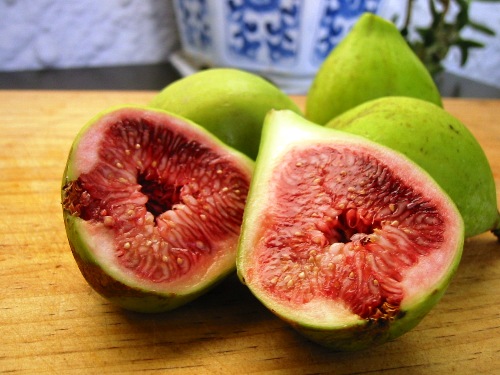
Virgil Evetts
Autumn proper is just about upon us. Mellow fruitfulness abounds, daylight saving has nearly danced its final flourish, and the leaves are all a-blushing. Sitting snugly between parched summer and dreary, dank winter, mid-autumn is peak season for some of the year’s most eagerly anticipated produce: figs, quince, feijoa, pears, apples and more. And that’s just the fruit.
Elsewhere pumpkins, potatoes and kumara abound. The nights now are cool enough for sticky, golden-hued roasts, and the first furtive thoughts of stews, casserole and tagines yet to come.
Pears
Pears are a rarity among fruit – not only do they ripen off the tree, they ripen far better off the tree than on. Simply place rock-hard supermarket pears in a paper bag and leave well alone for a few days. As they exhale ethylene gas they will ripen together into buttery, perfumed and indecently juicy bliss. If you’ve never had a properly ripened pear, you’ve really never had a pear at all.
There are numerous pear varieties grown and sold on the local market (although curiously, little new development in decades), each with their own special nuances. Sample a few to find your favourite. My personal choice is Seckle, a small intensely fragrant pear with a gorgeously fine texture. Sadly, only available from Farmers Markets (or your own backyard).
Feijoa
Feijoas are real kiwi icons. Kids around my neighbourhood sell them kerbside by the bucket full every year, and I can never resist. Feijoa are a member of the guava family (related to pohutukawa too) from the South American highlands. Curiously New Zealand is one of only a couple of places outside of their home range where they are grown, and eaten with such relish.
The best gauge of ripeness in feijoa is fragrance- they should be heavily, almost cloyingly fragrant. Ripe fruit should be firm, but yield slightly when pressed with the thumb. Avoid bruised and squishy fruit. If you’re looking for ways to tackle the inevitable neighbourhood glut, don’t overlook feijoa wine. Easy to make and utterly delicious.
Quinces
Few fruits get more coverage in the magazines and newspapers than quince. So I’ll keep it brief. But make no mistake, quince are worth all the fuss. Their deep, rose-meets-pear flavour is just sublime, and their transformation from pasty yellow to blood-stain red is remarkable. Follow your nose to the nearest fragrant haul, and buy up large. Cook quinces long and slow. Savour every mouthful.
Ripe quinces should be yellow and very, very firm. They are inedible raw.
Note: Japonica quinces occasionally turn up at farmers’ markets. These taste very different to their more common European (actually central Asian) counterparts. Not remotely to my taste, but it takes all types…
Figs
God, I love figs. The way they splay open when fully ripe, baring their sticky, near-liquid pinkness to the world (including any passing bird, unfortunately). The smell of ripe fig is the defining smell of autumn, soon to be followed by wood smoke and cold air.
With their long, slow formation over summer , figs are powerfully sweet. I find they are best enjoyed just shy of full ripeness when they retain little sharp acidity.
Figs are either red/pink or white fleshed. The former are usually the more flavoursome of the two, whereas the latter (sometimes called sugar figs) tend towards excessive sweetness and a less rounded flavour.
Figs do not ripen well off the tree and are too fragile and fleeting to ship fully ripened. For this reason it is best to either grow your own or buy from a farmers’ market.
Pumpkins & squash
Pumpkins and squash are everywhere right now, and hopefully dirt-cheap. This is the time to buy in bulk and store for the months ahead. It’s a little-discussed fact that however counterintuitive it may feel, freshly picked pumpkins are rarely ready for eating. They tend to be starchy, watery and sometime slightly gritty. They need a good month or three in a dry, airy and ideally sunny spot to properly cure and ripen, during which time they should slide towards sweet, fudgy perfection.
When buying pumpkins in bulk look for specimens with their stalks intact: this helps to protect them from decay. Turn the pumpkins every week and check for soft patches or mould.
My favourite variety: can’t go past a butternut, rock-hard kumikumi and my new best-friend the tromboncino
Also in-store & in-season now:
Persimmons, Chinese fragrant pears, nashi, potatoes, kumara, garlic, apples, limes, peaches, nectarines, capsicums, chilli, silverbeet, Bluff oysters, Thai and Peruvian mango



I love figs but can never seem to get any good ones here in Rotorua. I would like to plant a tree but would like to know what variety the lovely green ones with the pink flesh (pictured) are. I don’t like the dark skinned ones as much.
Both our dogs adore figs as much as we do, & wait patiently every morning for their helpings of these delicious sweet treats– luckily we have two trees with more than enough for all to share, & extras to give away to friends.
Always love these in season articles, Virgil. You’ve certainly explained why my 99 cent fig from my fruit & vegie store wasn’t as flavoury as I thought it would be.
Butternut and Buttercup are both squash(even though they look so different), so similar in flavour. I find butternut to be sweeter and consistently dryer fleshed than butternut. Buttercup is a very nice squash though.
Just a quick question for you regarding pumpkins…
I typically use Buttercup pumpkins as we really like the dry texture of them, and it is rare for them to be watery.
How does a butternut compare to a buttercup?